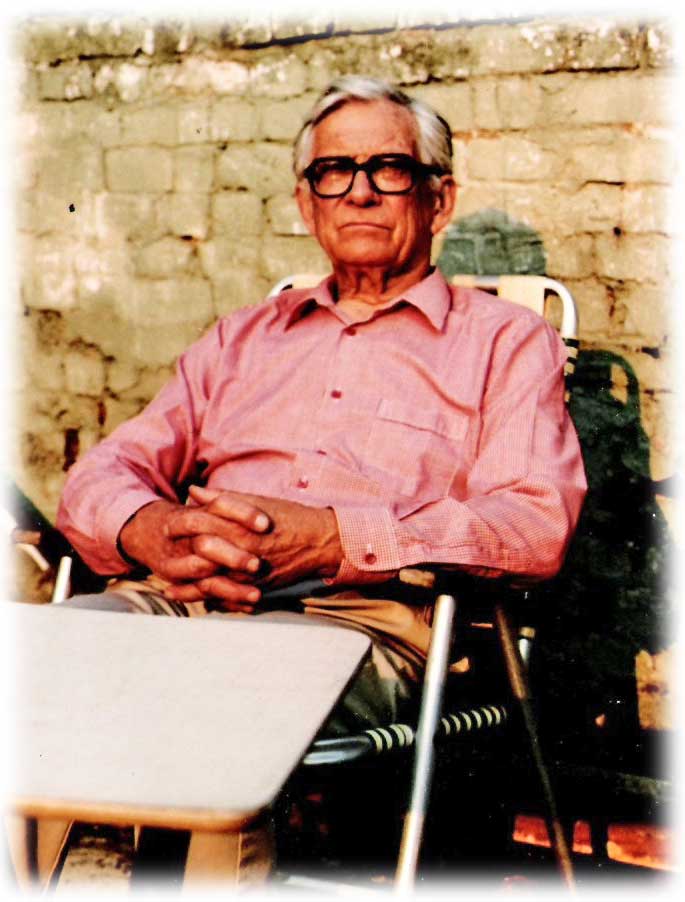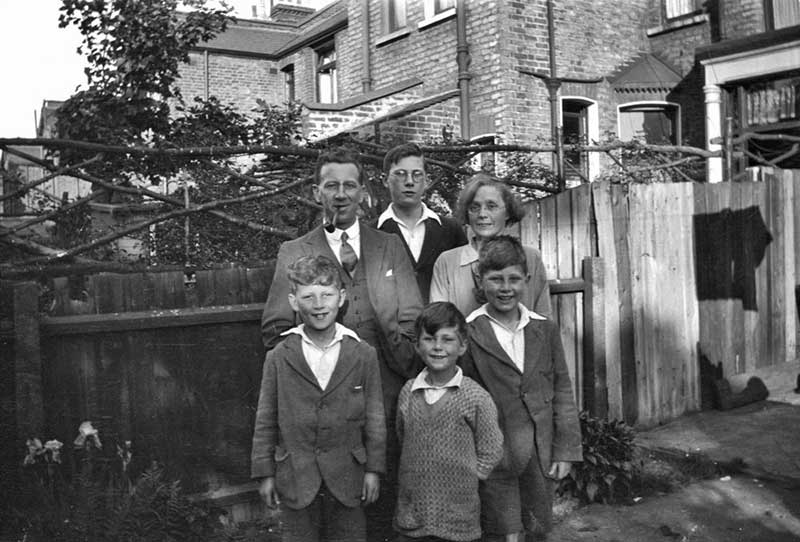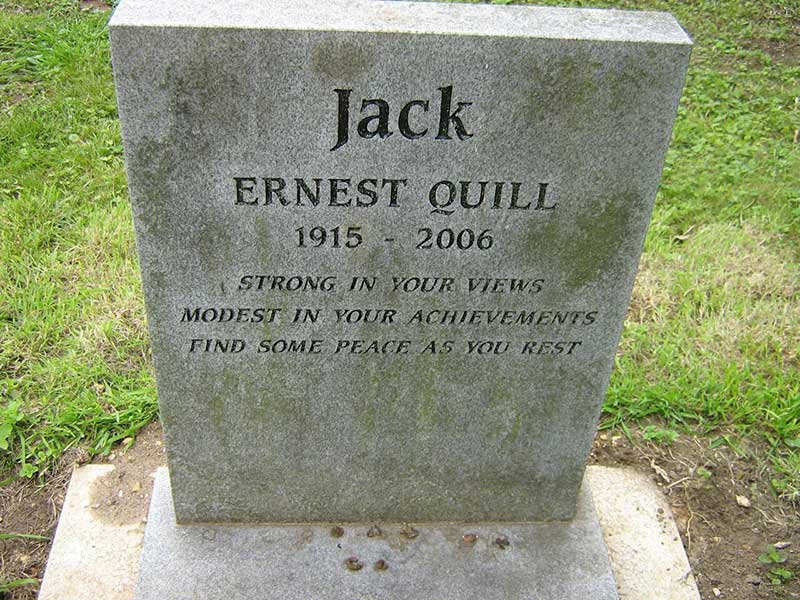|
History menu >
Memories of journalist Ernest Jack Quill DCM
This page has no connection to Malvern
 Overview Overview
A member of the family married journalist Ernest Jack Quill in the 1950s. See
photo opposite of Jack which was taken in 1989 (source: S Quill). Jack
worked for George Newnes and the IPC group, sometimes writing for a racing
column, or about properties for sale in Country Life. He also wrote a column
for the Daily Telegraph under the name Peterborough, or some such, where he
was able to express his view of topical events; another pen name he used was
Broadacre. Jack had a spirited West
Highland Terrier named Monty and liked to
walk him on Leith Hill and have a quick pint at Coldharbour before returning
home for Sunday lunch.
Early Life
Jack was born at Ilford on 23rd February 1915, the eldest
son of Ernest Casson Quill and his first wife Marguerite Dixon. The 1911
census records Ernest Casson Quill as a clerk in a chemical factory, and his
father James, born on the Isle of Man, as a Lay Reader and a member of the Church of
England Scripture Readers' Association. The Scripture Reading Association
had been founded by the Bishop of London and others about 1850 to provide
help to overstretched clergy in metropolitan districts.
When Jack's grandfather James married in 1884 he had
described himself as an 'Evangelist in the Hallelujah Band'. In the latter
half of the 1800s there was concern that the working classes were not
attending church and 'Hallelujah Bands' allied to preaching by working class
evangelists became fashionable in an attempt at outreach; the Salvation Army
bands being a surviving example of this. Jack had a deep booming voice and
one could imagine his grandfather
reading out passages from scripture either in church or at public
gatherings.
The photo below taken about 1930 shows Jack with his
parents and younger brothers Philip, Eric and James (source: S Quill). His mother
died shortly after this photo was taken.

The Quill family, Jack centre rear
Jack's early working life was interrupted by the Second World War.
 Jack never mentioned that his brother
Philip Quill,
Sergeant, 775038, RAF Volunteer Reserve died, aged 21 years, on 21 Sep 1940,
at RAF Finningley, when he walked into a propellor after returning from a
night flight. Jack never mentioned that his brother
Philip Quill,
Sergeant, 775038, RAF Volunteer Reserve died, aged 21 years, on 21 Sep 1940,
at RAF Finningley, when he walked into a propellor after returning from a
night flight.
Jack joined the King's Royal Rifle Corps (KRRC) and fought
in the desert of North Africa with Montgomery and the 8th Army. Later the
KRRC was deployed to Italy with the 9th Armoured Brigade as part of 1
Canadian Corps, but Jack never mentioned, nor did we know until after his death,
that he had
been awarded the
Distinguished Conduct Medal
in 1945 for an action in Italy during World War II.
Distinguished Conduct Medal
The
transcription of the citation, held by the National Archives, reads:
9 Amoured Brigade, 5 Canadian Armoured Division, 1 Canadian Corps
Unit: 1st Bn KRRC
Army No and Rank: 6857254, W/Corporal
Name: Quill, Ernest Jack
For outstanding courage and determination in assuming the duties of
Platoon Commander after being wounded. On 1st Jan 1945, Corporal Quill's
platoon was holding a position in and around a house at MR 482462 ITALY
1:25,000 89 III NW. Corporal Quill's section was responsible for a bren
position in the farmyard. At about 0300 hours the area was mortared, the
listening post driven in, and the position surrounded by a strong enemy
raiding party. Corporal Quill was badly wounded in the shoulder by a spandau
bullet but continued firing his bren gun with the utmost determination and
prevented any enemy entering his sector. However, the outside posts on
another flank were neutralised, enemy entered the farmyard and bazooked
the house, which collapsed except for a small part of the ground floor. All
the posts in the house ceased firing and it was clear that unless they could
be brought into action the whole position would be over-run with the
possible exception of Corporal Quill's gun post. The only way in was across
the open farm yard, which was brightly lit by burning haystack and through
the door, which was under constant fire. Corporal Quill entered the
building, where he found the platoon commander, platoon sergeant and several
riflemen were wounded, one section commander and two riflemen were missing.
Corporal Baptist and the few riflemen still in action were dazed and injured
by debris, most of the weapons and ammunition were damaged or buried under
debris. Helped by Corporal Baptist he reorganised the platoon, and organised
the fire positions and treatment of the wounded. As soon as the the position
in the house had been restored he again crossed the open yard with one
rifleman to occupy an outside post from which he engaged the enemy until
they withdrew. After relieving forces arrived, Corporal Quill completed the
reorganisation of his platoon and stayed at his post until ordered back to
the Rv by an officer when the full severity of his wound was discovered.
This NCO's fighting spirit and self sacrifice were a magnificent example to
his platoon. His courage and determination saved a very ugly situation.
Granted an immediate DCM
HR Alexander
Field Marshall
Supreme Allied Commander in Chief
Mediterranean
The signatures approving Jack's award were difficult to read, but
appeared to be,
- E A W Williams, Lieut Colonel, Commanding 1 KRRC
- R B B B Cooke, Brigadier, Commander 9 Armoured Brigade
- C F Keightley, Lt General, GOC Eighth Army
and we wondered who these officers were.
Not surprisingly they were all career soldiers who were educated at Public
Schools and attended the Royal Military College, Sandhurst.
Field Marshal
Harold Rupert Leofric George Alexander, 1st Earl Alexander of
Tunis, KG, GCB, OM, GCMG, CSI, DSO, MC, CD, PC, was a senior officer of the
British Army, who served with distinction in both World Wars. Educated
Harrow and the Royal Military College Sandhurst.
Lt Col
Edward Alexander Wilmot Williams (1910 - 1994)
was the son of Captain BCW Williams, JP, DL, Herringston, Dorchester and
Hon Winifred Mary Williams (MBE 1920), elder daughter of 2nd Baron
Addington. He married in 1943 Sybilla Margaret Archdale, daughter of Col Osmund
Audley Archdale. Educated Eton and the Royal Military
College, Sandhurst.
Brigadier Ronald Basil Bowen Bancroft Cooke (1899 - 1971) CBE, DSO, CB was
the son of Lt Col Sydney Cooke, Orwell Lodge, Horsham; educated Charterhouse
and the Royal Military College, Sandhurst; served with the Royal Armoured
Corps, and rose to the rank of Major General.
Career soldier,
Lt Gen Sir
Charles Frederic Keightley (1901 - 1974) DSO, GCB, Legion of
Merit, was the son of clergyman Rev CA Keightley. Educated Marlborough
College and the Royal Military College, Sandhurst. Married in 1932 Joan Lydia, daughter of late
Brig Gen GNT Smyth Osbourne, CB, CMG, DSO, of Ash, Iddesleigh, North Devon.
Up until 1993, different medals for gallantry were awarded to officers and
to 'other ranks'. This nonsense was abolished by Prime Minister John Major
and replaced by new series of medals open to all ranks. Jack's medal
probably equates to the new 'Conspicous Gallantry Cross', which is at a
level below the Victoria Cross.
Later life
After the war Jack worked as a journalist in London,
living for a while at Raynes Park, before moving to Dorking, and finally, in
his last years, living at Anmer where his house was on, and rented from, the
Queen's Estate at
Sandringham. He joked he could eat the Queen's apples, and nowadays of
course you can visit the
Sandringham orchards in the autumn and pick your own.
Independent in his views, he had an enquiring mind and
was good with children, treating them as adults, despite having no children
of his own.
Death
 Jack
died at King's Lynn on 30th March 2006, aged 91 years and is buried in Anmer
churchyard. Jack
died at King's Lynn on 30th March 2006, aged 91 years and is buried in Anmer
churchyard.
The inscription on his headstone reads:
Jack
Ernest Quill
1915 - 2006
Strong in your views
Modest in your achievements
Find some peace as you rest
Jack's life and outlook were no doubt coloured by his experiences during the
war, as were the lives of many.
You can find out more about his family on the
Quill's Queries
website
References
- National Archives
- Communications from S Quill January - August 2016

Back to top
|

